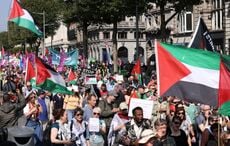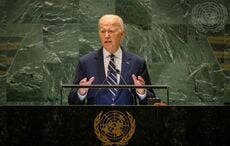It was fate that brought my husband and I on vacation from the U.S. to the round table at Gleeson’s, the popular bed and breakfast in Roscommon Town Square many years ago.
Seated at our side, the affable proprietor offered suggestions and pointed us toward local inhabitants who could be helpful in our search for Roscommon’s past. “You really must talk with Ruairí Ó’Brádaigh. He’s an expert on local history, and really into that stuff.”
That recommendation was all that was needed to spur us out the door and down Main Street headed toward the Abbey Hotel. Further along the Galway Road, my husband and I found the proper house number. We had arrived unannounced. Dressed in a suit, Ó’Brádaigh cordially invited us into the parlor, and proceeded to talk with us about the early days of the Volunteers in Roscommon.
Our interview was soon interrupted by a television camera crew from the BBC. Asked to return several hours later, we exited the cottage only to come back for more reminiscences about the Black and Tan War and the men who fought in it. Family medals were shared over tea in the kitchen as the profile of a devout Republican began to emerge.
Born Peter Roger Casement O’Bradaigh in 1932 in Longford town, he was called Rory (the Hiberno-English translation of Roger). During his secondary (high school) years at St. Mel’s, he sat next to the boy who would become this author’s parish priest in Oregon. Father Joe Black well remembered his school chum’s escapades at the old Dillon House in Loughglynn, with the nuns leaning out the second storey windows shouting at the embracing boys and girls, “Not in this holy place!”
His father was an avid Republican who had been badly wounded in the Black and Tan War, and later served as the Chairman of the Easter Rising Commemorative Ceremony. His great aunt, having been burned out of her Belfast home, suffered health problems as a result of the trauma, and spent five years in a mental hospital. Ó’Brádaigh’s mother was an Irish speaker, who instilled in her son not only a love of the native tongue but a reverence for the sacrifices of past patriots. She had been active in the Cumann na mBan.
An eight-year-old’s brush with Republican milestones directed this young boy to a road of political activism. On the morning of 7 February 1940, his father checked his watch, and when the small hand pointed to nine and the longer hand snapped to twelve, the elder Ó’Brádaigh turned to his son and daughter and said, “Kneel down and say your prayers. Two Irishmen now lie into quicklime in Birmingham.” (Peter Barnes and James McCormack were hanged for their supposed participation in a bombing in Coventry.)
Two months later a funeral cortege inched through Longford town amid an assembly of reverential silence which was noted by the young lad. The death march honored Sean McNeela, hunger striker, who had died in St Brecin’s Hospital in Dublin while attempting to be recognised as a political prisoner rather than a common criminal.
The uncharacteristically somber behavior of the townspeople puzzled the youngster. Why were his neighbours and family so moved to quietness? Why were Irishmen dying in Irish jails? His quest for answers to these queries has prompted a lifelong search into the hearts of Irish men and women and into the fiery cauldron of Irish politics.
Rory Brady left Longford in 1950 and headed to Dublin as a student at University College Dublin (UCD). He was soon a student of the IRA as well, and his classroom became the Sinn Féin office in Parnell Square. At this juncture in his life, he changed his name to its Irish form—Ruairí Ó’Brádaigh.
He returned to Longford where he helped to organise local units of the IRA and reported his activities directly to Tony Magan (Chief of Staff at the time). The first unit of the IRA that he organised in Longford was technically under the command of a Leitrim man—John Joe McGirl. Ó’Brádaigh’s primary responsibility was training his men in weapons care and explosives, a job he took seriously at their weekly meeting.
In 1953 he was an elected delegate to the IRA Army Convention. In the spring of 1954, he graduated from UCD with a degree in commerce and a certificate to teach that subject and the Irish language. When the autumn leaves began to flutter that year, he journeyed to Roscommon town where he took a position at the Roscommon Vocational School.
Ó’Brádaigh was active in the Border campaign and arrested for such activity. He headed the assault party on Arborfield on 13 August 1955 and was elected to the IRA Executive. He was arrested for his part in the attack of Derrylin Barracks on 30/31 December 1957 and sent to the Curragh, from which he escaped on 24 September 1958 along with Daithi O’Conaill. At the Army Convention in May of 1959, Ó’Brádaigh was voted Adjutant General under Sean Cronin. Six months later he was arrested in Roscommon town after attending a church service for the local school’s headmaster. Because he didn’t answer questions posed by the Gardaí, he was sentenced to six months in Mountjoy. Released on 26 May 1960, he returned to Longford amid public fanfare.
Ó’Brádaigh turned over the Chief of Staff position to Cathal Goulding on 7 September 1962 and returned to Roscommon town, where he taught in the local vocational school. In December of 1964, he was elected chairperson of the Roscommon Sinn Féin. In February 1966 he was selected as a Sinn Féin candidate for Fermanagh/Tyrone in the Westminster elections. But the shadow of “illegal activity” followed him. On 31 May 1972 as President of Sinn Féin, he was arrested and again sent to the Curragh, from which he was released a year later.
After leaving the military wing of the IRA, Ó’Brádaigh remained at the forefront of Irish politics. He was elected as president of Sinn Féin—a position he held until Gerry Adams succeeded him in 1983. A year later he and his wife, Patsy, and two of their children were involved in a car wreck that resulted in injuries which took months to heal. That same year he was elected Secretary of Roscommon Comhairle Ceantair and attended the Árd Fhéis as a delegate.
Totally committed to the legacy of a Republic and the eminence of the Second Dáil, the cornerstones of the Sinn Fein policy stood for armed struggle to achieve the Republic and rejection and avoidance of Leinster House as a corruption of the Republican ideals.
Ó’Brádaigh was, however, part of the negotiating team that achieved a truce and continued negotiations with the British in 1975. While the Irish were talking with the Crown representatives about withdrawal from Northern Ireland, the English were building H-Block (detention center in the north) and systematically handing over “peace keeping” duties to the enlarged RUC. The ceasefire broke down.
The year 1986 signaled a change in tempo. Younger members of the organisation reasoned that loaded guns were appropriate weapons to be aimed northward, but capture of the southern government was going to have to be attempted by a different strategy. Note from Ó’Brádaigh’s own pen: “Since the end of the Irish Civil War in 1923, no one—Republican or other—had attempted to overturn the Dublin parliament or Leinster House by force. This is historical fact. But why accept the established though partitionist and collaborationist twenty-six county parliament?” (Private correspondence October 22, 1996.)
How then was Sinn Féin going to overtake the Dublin government and refocus its legislation? The answer goes back to the original idea of Sinn Féin―to succeed in electing candidates who would exhibit their contempt for the British Parliament by not taking a seat in its chambers; however, the resolution passed at the 1986 convention of Sinn Féin specifically directed its members to challenge delegates at the voting polls and to take their seats in the twenty-six county Dáil thus challenging its policies.
Like De Valera in the late 1920s, the younger leadership of Sinn Féin felt isolated and unable to affect change while sitting on the sidelines watching the game being played out. Rather than trying to construct an All Ireland parliament with new perimeters and new rules, the younger members chose to become players in the Dublin Dáil. They felt that to be a part of the tournament, they had to get off the bench and onto the court.
Ó’Brádaigh, who always treasured the abstentionist policy, could not swallow this unpalatable pill of parliamentary politics. He and his comrades objected to this strategy by pointing out that all who have formerly accepted the twenty-six county state have ended up abandoning the freedom fight in the North and helping the British rule it. They feared the young turks (the Provisional IRA) would be soaked up in this same morass. Thus he, along with other prominent Republicans, splintered off from the Provisional IRA and started a new party, Republican Sinn Féin. He was President of that organisation until he resigned due to age and ill health in October 2009. After a battle with cancer, he died 5 June 2013.
Worries of financial security (he fought the government for his teacher’s pension for years), the death of a sister, and the back-and-forth arguments of litigation regarding his car accident all contributed to a stroke suffered in 1989. His constant companion thereafter was a cane.
As a new millennium unfolded, Ó’Brádaigh continued his political activities: attending commemorations, visiting the office of Republican Sinn Féin in Dublin, issuing statements that clarified his position. In 2005, for only the second time in his long political life, he gave the key oration at Bodenstown. Like Wolfe Tone, he no doubt took his long-held Republican beliefs to the grave. What words best express his life’s dream? They are but two—Brits out!




Comments